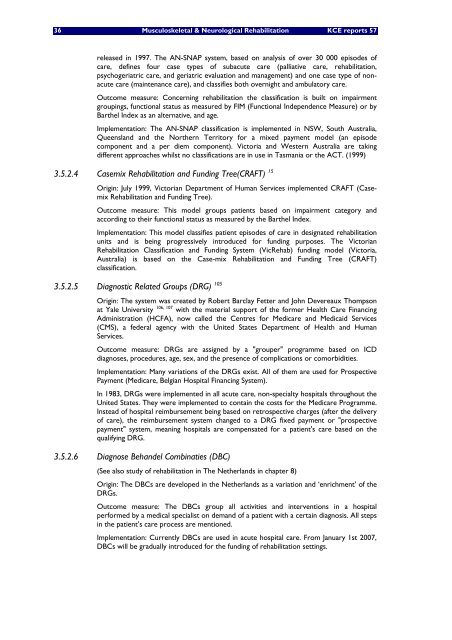The report is available in English with a French summary - KCE
The report is available in English with a French summary - KCE
The report is available in English with a French summary - KCE
You also want an ePaper? Increase the reach of your titles
YUMPU automatically turns print PDFs into web optimized ePapers that Google loves.
36 Musculoskeletal & Neurological Rehabilitation <strong>KCE</strong> <strong>report</strong>s 57<br />
released <strong>in</strong> 1997. <strong>The</strong> AN-SNAP system, based on analys<strong>is</strong> of over 30 000 ep<strong>is</strong>odes of<br />
care, def<strong>in</strong>es four case types of subacute care (palliative care, rehabilitation,<br />
psychogeriatric care, and geriatric evaluation and management) and one case type of nonacute<br />
care (ma<strong>in</strong>tenance care), and classifies both overnight and ambulatory care.<br />
Outcome measure: Concern<strong>in</strong>g rehabilitation the classification <strong>is</strong> built on impairment<br />
group<strong>in</strong>gs, functional status as measured by FIM (Functional Independence Measure) or by<br />
Barthel Index as an alternative, and age.<br />
Implementation: <strong>The</strong> AN-SNAP classification <strong>is</strong> implemented <strong>in</strong> NSW, South Australia,<br />
Queensland and the Northern Territory for a mixed payment model (an ep<strong>is</strong>ode<br />
component and a per diem component). Victoria and Western Australia are tak<strong>in</strong>g<br />
different approaches whilst no classifications are <strong>in</strong> use <strong>in</strong> Tasmania or the ACT. (1999)<br />
3.5.2.4 Casemix Rehabilitation and Fund<strong>in</strong>g Tree(CRAFT) 15<br />
Orig<strong>in</strong>: July 1999, Victorian Department of Human Services implemented CRAFT (Casemix<br />
Rehabilitation and Fund<strong>in</strong>g Tree).<br />
Outcome measure: Th<strong>is</strong> model groups patients based on impairment category and<br />
accord<strong>in</strong>g to their functional status as measured by the Barthel Index.<br />
Implementation: Th<strong>is</strong> model classifies patient ep<strong>is</strong>odes of care <strong>in</strong> designated rehabilitation<br />
units and <strong>is</strong> be<strong>in</strong>g progressively <strong>in</strong>troduced for fund<strong>in</strong>g purposes. <strong>The</strong> Victorian<br />
Rehabilitation Classification and Fund<strong>in</strong>g System (VicRehab) fund<strong>in</strong>g model (Victoria,<br />
Australia) <strong>is</strong> based on the Case-mix Rehabilitation and Fund<strong>in</strong>g Tree (CRAFT)<br />
classification.<br />
3.5.2.5 Diagnostic Related Groups (DRG) 105<br />
Orig<strong>in</strong>: <strong>The</strong> system was created by Robert Barclay Fetter and John Devereaux Thompson<br />
at Yale University 106, 107 <strong>with</strong> the material support of the former Health Care F<strong>in</strong>anc<strong>in</strong>g<br />
Adm<strong>in</strong><strong>is</strong>tration (HCFA), now called the Centres for Medicare and Medicaid Services<br />
(CMS), a federal agency <strong>with</strong> the United States Department of Health and Human<br />
Services.<br />
Outcome measure: DRGs are assigned by a "grouper" programme based on ICD<br />
diagnoses, procedures, age, sex, and the presence of complications or comorbidities.<br />
Implementation: Many variations of the DRGs ex<strong>is</strong>t. All of them are used for Prospective<br />
Payment (Medicare, Belgian Hospital F<strong>in</strong>anc<strong>in</strong>g System).<br />
In 1983, DRGs were implemented <strong>in</strong> all acute care, non-specialty hospitals throughout the<br />
United States. <strong>The</strong>y were implemented to conta<strong>in</strong> the costs for the Medicare Programme.<br />
Instead of hospital reimbursement be<strong>in</strong>g based on retrospective charges (after the delivery<br />
of care), the reimbursement system changed to a DRG fixed payment or "prospective<br />
payment" system, mean<strong>in</strong>g hospitals are compensated for a patient's care based on the<br />
qualify<strong>in</strong>g DRG.<br />
3.5.2.6 Diagnose Behandel Comb<strong>in</strong>aties (DBC)<br />
(See also study of rehabilitation <strong>in</strong> <strong>The</strong> Netherlands <strong>in</strong> chapter 8)<br />
Orig<strong>in</strong>: <strong>The</strong> DBCs are developed <strong>in</strong> the Netherlands as a variation and ‘enrichment’ of the<br />
DRGs.<br />
Outcome measure: <strong>The</strong> DBCs group all activities and <strong>in</strong>terventions <strong>in</strong> a hospital<br />
performed by a medical special<strong>is</strong>t on demand of a patient <strong>with</strong> a certa<strong>in</strong> diagnos<strong>is</strong>. All steps<br />
<strong>in</strong> the patient’s care process are mentioned.<br />
Implementation: Currently DBCs are used <strong>in</strong> acute hospital care. From January 1st 2007,<br />
DBCs will be gradually <strong>in</strong>troduced for the fund<strong>in</strong>g of rehabilitation sett<strong>in</strong>gs.

















